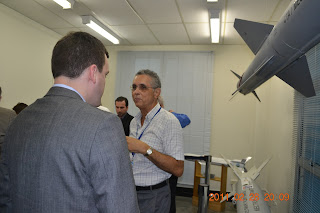While the majority of the group was visiting the Petrobras research center, the rest of us went to the non-destructive testing, corrosion and welding research laboratory of the Federal University of Rio de Janeiro (UFRJ). The laboratory was funded by Petrobras (PB), which finances about 70% of the costs. The rest of the financing is coming from the government and some cooperating companies. There are about 50 people working in the facility, where Adriana, one of the researchers in the metallurgy department showed us around, accompanied by specialists of each experimental setup.
The experiments are mainly carried out to serve Petrobras, but also its allied companies. For the corrosion tests, the samples are exposed to CO2 and H2S, gasses that are present when extracting oil. The devices are placed in fixtures and inserted into the test chamber for a test period of a few weeks to several months. Often chemically produced sea water is also used to get a realistic test environment. In reality, the samples are represented by tubes subjected to large pressures from the oil and the sea water, why some corrosion experiments are carried out with static loads present. After the experiments the samples are carefully analyzed using microscopy, x-ray etc. The UFRJ have made the standards themselves to serve their requirements on the materials. The labs are well maintained and the gasses are effectively collected and neutralized according to the requirement in the Kyoto protocol. The equipment is cleaned with nitrogen between each experiment to get reliable results.
The center is currently building a new research lab for multiphase flow loop experiments, which should be one of the best in the world when it is ready to take in use in 2012. The setup is to be a 50 m loop of tubes that can be tilted from 0 to 90 degrees and that supports a very controlled mixture of flow, pressure, amount of different chemicals, temperature, pH and so on to analyze corrosion. At certain pressures in the tube, the gasses works in the supercritical region, making them extra aggressive to the tubes. The goal is to find less expensive materials that can be used for pre-salt layer oil drilling at an average depth of 5 km, since the todays nickel based alloys are very expensive, still without lasting 10 years as expected. The production of this oil, which has been observed to be of very good quality, is expected to start in 2012 outside of the Brazilian coast.
The tubes have several requirements, to resist certain chemicals from inside, others on the outside. They have to manage the high pressures as well as being flexible to allow it to be put on rolls. To get all these properties, the tubes consists of many layers of different materials, from steel and other alloys to glass fiber reinforced epoxy.
The tubes are welded in pieces of 12 m and the strengths of the welds are tested by lower it in a large pool and pressurized until it explodes, using a maximum pressure of 400-600 bar. Tests are carried out both on new and used tubes to observe the degradation. To inspect the weldings without destroying the pipe, mainly x-ray is used, but they have also equipment for radiography, ultrasonic measurements etc.
Since many pipes combine metal with layers of glass fiber epoxy, it can be tricky to find defects like cracks, bad adhesion between layers and so on. UFRJ are using three interesting techniques for this kind of analysis. One of them is based on acoustic emission (AE), meaning analysis of high frequency response form the pipe which can be used to find failures both in the metal and in the glass fiber. To find the weak areas of the pipe, they are using 3 or 4 AE-transducers, placed on strategic positions, enabling triangulation to locate the interesting points. The second setup is based thermal conductivity. By exposing the sample to a high power flash, the surface temperature is raised to about 40 degrees C and a thermal camera catches the unforced cooling at a frame rate of 30 Hz to find phase shifts, indicating defects. The method can be used to find failures to a deep of 8-9 mm from the surface. They demonstrated the method to us using a calibration plate, with amazingly good result. The third technique relies on ultrasonic, which they didn’t show in detail, but where newly bought equipment containing 64 channels will allow them to find the defects on pipes of length up to 12 m.
Finally they showed their 4-axis x-ray interferometer, a machine containing a unusual large chamber for the sample and a very fast detector and good primary optics. This machine can make an analysis as fast as in 15 minutes and is used for crystallographic analysis, welding, stress, film and micro diffraction measurements as well as textures experiments.
Posted by Kenneth





















